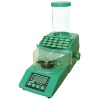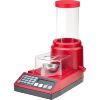In this test we used the Denver instruments APX-203 scale for a baseline

Scales to be tested are,
RCBS ChargeMaster 1500

Hornady Lock-N-Load Auto Charge

RCBS Powder Pro Digital Scale

Lyman 1000 XP Electronic Powder Scale

RCBS Model 1010 Magnetic Powder Scale

RCBS Model 505 Magnetic Powder Scale


Checked the weight of a 168gr Berger bullet, 87gr Hornady vmax, and a 250gr check weight
Here is what the weight was on the APX-203 Used as a baseline.
168.16
87.38
250.02
RCBS ChargeMaster 1500
168.1
87.4
250.00
Hornady Lock-N-Load Auto Charge
167.9
87.4
250.00
RCBS Powder Pro Digital Scale
167.8
87.2
249.7
Lyman 1000 XP Electronic Powder Scale
168.1
87.4
250.00
RCBS Model 1010 Magnetic Powder Scale
168.03
87.3
250.0
RCBS Model 505 Magnetic Powder Scale
168.2
87.3
250.1
Now on to the RCBS ChargeMaster 1500
Hornady Lock-N-Load Auto Charge
RCBS Uniflow Powder Measure, thrown only no trickle
10 charges with the target load of 43gr checked on the APX-203
Hornady Lock-N-Load Auto Charge, with Benchmark
43.16 17sec
43.16 20sec
43.24 20sec
43.46 20sec
43.20 20sec
43.12 18sec
43.12 20sec
43.26 18sec
43.12 19sec
43.16 20sec
ES .34gr
SD .098gr
RCBS ChargeMaster 1500, with Benchmark
42.94 24sec
43.06 19sec
43.04 14sec
43.06 18sec
42.96 11sec
42.98 20sec
43.02 17sec
42.94 20sec
43 20sec
42.96 14sec
ES .12gr
SD .075gr
RCBS Uniflow Powder Measure, with Benchmark
42.98 1sec
43.04 1sec
42.92 1sec
43.24 1sec
43 1sec
42.82 1sec
42.86 1sec
42.90 1sec
42.96 1sec
42.98 1sec
ES 42gr
SD .110gr
10 charges with the target load of 43gr checked on the APX-203
Hornady Lock-N-Load Auto Charge, with AR-Comp
43.24 18sec
43.36 22sec
43.32 19sec
43.16 18sec
43.04 20sec
43.20 17sec
43.44 19sec
43.28 20sec
43.10 20sec
43.22 21sec
ES .40gr
SD .114gr
RCBS ChargeMaster 1500, with AR-Comp
42.98 16sec
42.92 20sec
42.92 19sec
42.90 24sec
42.92 13sec
43.02 16sec
42.96 26sec
42.96 21sec
43.04 20sec
43 20sec
ES .14gr
SD .045gr
RCBS Uniflow Powder Measure, with AR-Comp
43 1sec
42.98 1sec
43.12 1sec
43.12 1sec
43.08 1sec
42.92 1sec
42.88 1sec
42.94 1sec
42.88 1sec
42.96 1sec
42.98 1sec
ES .24gr
SD .082gr
10 charges with the target load of 43gr checked on the APX-203
Hornady Lock-N-Load Auto Charge, with H-4350
43.8
43.12
43.04
43.16
43.16
43.16
43.22
43.20
43.16
43.18
ES .76gr
SD .198gr
RCBS ChargeMaster 1500, with H-4350
43
42.9
43.02
42.96
43.02
43.04
42.98
42.94
42.90
43.06
ES .16gr
SD .053gr
RCBS Uniflow Powder Measure, with H-4350
42.94
42.88
43.08
42.90
42.96
42.96
42.86
42.96
42.96
42.96
ES .20gr
SD .057gr
Up to this point the RCBS was at factory settings. We then did the McDonald's Straw mod and changed some settings on the RCBS ChargeMaster to make it faster, with H-4350
43.08
43.02
43.08
43.02
43.02
42.96
42.96
43
42.9
43
ES .18gr
SD .051gr
This improved the average time from 20.5sec to 14.4 seconds over a 10 throw average
Here is a video on how to do that.
http://www.youtube.com/watch?v=vbG2Mw4b4a0&feature=share&list=UUJpcXEbKcTfLOG_NsUiyRxg
Testing done by
Eric S
Clayne B

Scales to be tested are,
RCBS ChargeMaster 1500

Hornady Lock-N-Load Auto Charge

RCBS Powder Pro Digital Scale

Lyman 1000 XP Electronic Powder Scale

RCBS Model 1010 Magnetic Powder Scale
RCBS Model 505 Magnetic Powder Scale


Checked the weight of a 168gr Berger bullet, 87gr Hornady vmax, and a 250gr check weight
Here is what the weight was on the APX-203 Used as a baseline.
168.16
87.38
250.02
RCBS ChargeMaster 1500
168.1
87.4
250.00
Hornady Lock-N-Load Auto Charge
167.9
87.4
250.00
RCBS Powder Pro Digital Scale
167.8
87.2
249.7
Lyman 1000 XP Electronic Powder Scale
168.1
87.4
250.00
RCBS Model 1010 Magnetic Powder Scale
168.03
87.3
250.0
RCBS Model 505 Magnetic Powder Scale
168.2
87.3
250.1
Now on to the RCBS ChargeMaster 1500
Hornady Lock-N-Load Auto Charge
RCBS Uniflow Powder Measure, thrown only no trickle
10 charges with the target load of 43gr checked on the APX-203
Hornady Lock-N-Load Auto Charge, with Benchmark
43.16 17sec
43.16 20sec
43.24 20sec
43.46 20sec
43.20 20sec
43.12 18sec
43.12 20sec
43.26 18sec
43.12 19sec
43.16 20sec
ES .34gr
SD .098gr
RCBS ChargeMaster 1500, with Benchmark
42.94 24sec
43.06 19sec
43.04 14sec
43.06 18sec
42.96 11sec
42.98 20sec
43.02 17sec
42.94 20sec
43 20sec
42.96 14sec
ES .12gr
SD .075gr
RCBS Uniflow Powder Measure, with Benchmark
42.98 1sec
43.04 1sec
42.92 1sec
43.24 1sec
43 1sec
42.82 1sec
42.86 1sec
42.90 1sec
42.96 1sec
42.98 1sec
ES 42gr
SD .110gr
10 charges with the target load of 43gr checked on the APX-203
Hornady Lock-N-Load Auto Charge, with AR-Comp
43.24 18sec
43.36 22sec
43.32 19sec
43.16 18sec
43.04 20sec
43.20 17sec
43.44 19sec
43.28 20sec
43.10 20sec
43.22 21sec
ES .40gr
SD .114gr
RCBS ChargeMaster 1500, with AR-Comp
42.98 16sec
42.92 20sec
42.92 19sec
42.90 24sec
42.92 13sec
43.02 16sec
42.96 26sec
42.96 21sec
43.04 20sec
43 20sec
ES .14gr
SD .045gr
RCBS Uniflow Powder Measure, with AR-Comp
43 1sec
42.98 1sec
43.12 1sec
43.12 1sec
43.08 1sec
42.92 1sec
42.88 1sec
42.94 1sec
42.88 1sec
42.96 1sec
42.98 1sec
ES .24gr
SD .082gr
10 charges with the target load of 43gr checked on the APX-203
Hornady Lock-N-Load Auto Charge, with H-4350
43.8
43.12
43.04
43.16
43.16
43.16
43.22
43.20
43.16
43.18
ES .76gr
SD .198gr
RCBS ChargeMaster 1500, with H-4350
43
42.9
43.02
42.96
43.02
43.04
42.98
42.94
42.90
43.06
ES .16gr
SD .053gr
RCBS Uniflow Powder Measure, with H-4350
42.94
42.88
43.08
42.90
42.96
42.96
42.86
42.96
42.96
42.96
ES .20gr
SD .057gr
Up to this point the RCBS was at factory settings. We then did the McDonald's Straw mod and changed some settings on the RCBS ChargeMaster to make it faster, with H-4350
43.08
43.02
43.08
43.02
43.02
42.96
42.96
43
42.9
43
ES .18gr
SD .051gr
This improved the average time from 20.5sec to 14.4 seconds over a 10 throw average
Here is a video on how to do that.
http://www.youtube.com/watch?v=vbG2Mw4b4a0&feature=share&list=UUJpcXEbKcTfLOG_NsUiyRxg
Testing done by
Eric S
Clayne B
Last edited:

